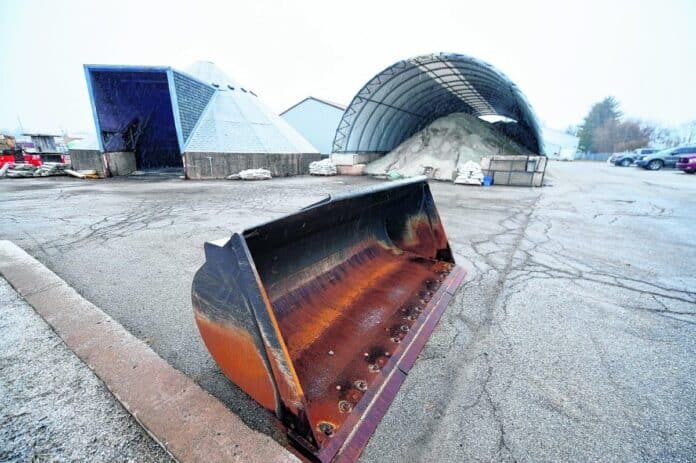
GREENFIELD — Winter has been relatively mild so far this year in Hancock County, with no significant snowfall since mid-December and few full-scale snow-plowing operations. For the budgets of those responsible for clearing streets and roads, that could be a good thing.
Gary Pool, Hancock County engineer, said the county’s highway department has saved money on overtime pay, which kicks in during around-the-clock road-clearing efforts. The real savings, however, will likely come in 2021. Each year, the county purchases road salt in bulk to use throughout the winter as needed. If the department does not have to use much salt this winter, it will be able to stockpile the leftover material for next year and buy less.
Salt is a major expenditure for the highway department, Pool said, “which is always heart-breaking, because you put it down and a few days later it’s gone.” For the winter of 2019-20, the department purchased 1,200 tons of salt at a rate of $100 per ton.
[sc:text-divider text-divider-title=”Story continues below gallery” ]Click here to purchase photos from this gallery
Tyler Rankins, street commissioner for the city of Greenfield, said the city would likely see similar savings.
“Obviously, the savings right off the bat is the overtime,” Rankins said.
The city might also be able to make a smaller salt purchase next year. It spent about $20,000 on that expense for 2019-20.
Rankins said this winter has stood out with a particularly low level of snowfall, but the weather has been mild for the past few years.
Plowing snow during the winter can be hard on both the vehicles and their drivers, Pool said. The mild winter might help avoid both repair costs and turnover in the department.
“It’s probably the most stressful job,” Pool said.
Pool said he gives out an award every year to the driver in the department who racks up the most hours of plowing without an accident. In the winter of 2013-14, an unusually harsh winter, the winner came in at 364 hours. Last year, the winning total was 144 hours.
So far this winter, the top plow driver has completed about 50 hours.
There are signs that the department may be spending less on road repairs as well. Pool said he was 40 work orders to complete currently; during some winters, that number can get up to 300 or 400. The department can spend up to $60,000 a year fixing potholes, which are often caused by freezing on the roads followed quickly by warmer weather.
“Even just a little bit of ice costs us a lot of money,” Pool said.
If the winter continues to be mild, Pool said, the highway department can expect to spend about 50% to 75% of the funds it would in a normal year. The remainder of those funds could be spent on other road repair projects.
The county has also seen fewer accidents than in a typical winter, Pool said, though he does not yet have official numbers for the season. He said the majority of serious and fatal accidents tend to occur in the summer, however, when less experienced and less confident drivers feel more comfortable taking to the roads.
Still, Pool said, he’s not ready to say the department is out of the woods yet.
“I’ve been walloped in February and March,” he said. “We’ve been walloped in April.”
Rankins agreed that he would not be counting on major savings.
“We can’t count our chickens before they hatch. It’s Indiana, and it can change on a dime,” he said.
Indiana Department of Transportation spokesperson Mallory Duncan said it will not be clear until the spring whether the state has saved any money due to mild winter weather. Any budgeted money that has not been spent will go to other projects during the year, she said.
[sc:pullout-title pullout-title=”By the numbers” ][sc:pullout-text-begin]
10.7: Amount, in inches, of snow that has fallen since November central Indiana. The normal amount is about 17 inches.
0.3: Amount, in inches, of snow that fell in January.
35: Average temperature in January. That is 6.9 degrees warmer than normal.
Source: National Weather Service
[sc:pullout-text-end][sc:pullout-title pullout-title=”Warmer Indiana winters” ][sc:pullout-text-begin]
This winter has been a relatively warm one in Indiana, but is that part of a pattern? According to a 2018 report from the Indiana Climate Change Impacts Assessment at Purdue University, it’s what scientists would expect to see in a changing global climate.
"Indiana’s climate is changing. Temperatures are rising, more precipitation is falling and the last spring frost of the year has been getting steadily earlier," the report said. "The data, going in some cases back to 1895, show clear trends, and there are no signs of them stopping or reversing."
Since 1895, the average temperature in the state has risen by approximately 1.2°F. It is expected to keep rising, along with the average global temperature.
As the climate continues to change, Indiana can expect to see more precipitation, a longer frost-free season, and overall higher average temperatures.
"These shifts will impact air quality, extend the growing season and the allergy season, and create more favorable conditions for some pests and invasive species," the report said.
[sc:pullout-text-end]
